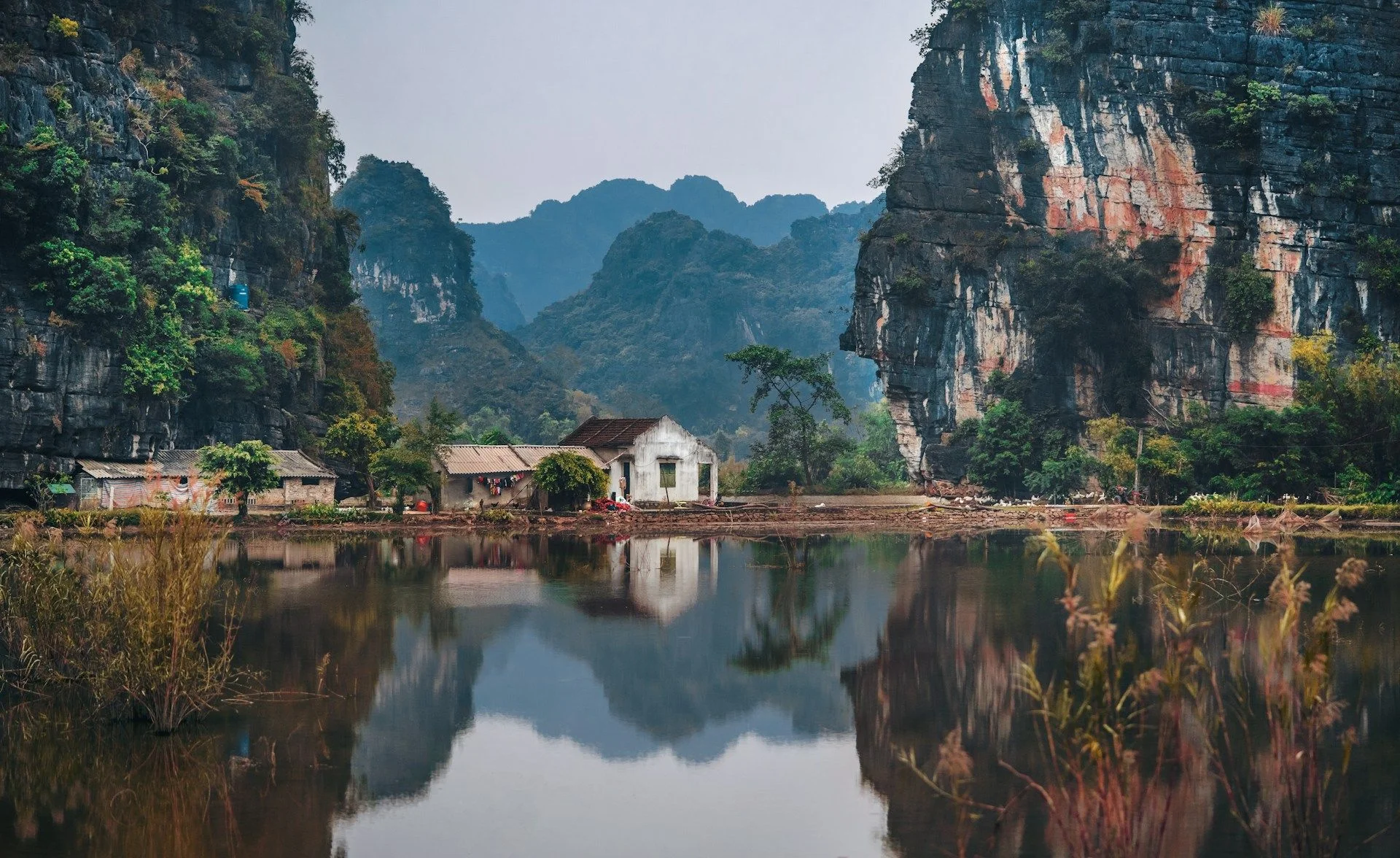Advantages of traveling
to Vietnam
Mekong Delta Cruises
Navigate winding waterways aboard traditional sampans, visit floating markets in Cai Rang, observe stilt villages, and sample fresh tropical fruits and local specialties at riverside eateries for authentic immersion into rural life.
Heritage Street Food
Savor banh mi, pho, and banh xeo from street vendors in Hanoi’s Old Quarter and Saigon’s markets; learn Vietnamese cooking in hands-on workshops, then join tasting tours showcasing authentic culinary traditions.
Highland Adventures
Trek terraced rice paddies in Sapa, sunrise over Fansipan Peak via cable car, explore ethnic minority villages, and discover cascading waterfalls in Ba Be National Park for a high-altitude Vietnamese escape.
Mekong Delta Cruises
Navigate winding waterways aboard traditional sampans, visit floating markets in Cai Rang, observe stilt villages, and sample fresh tropical fruits and local specialties at riverside eateries for authentic immersion into rural life.
Heritage Street Food
Savor banh mi, pho, and banh xeo from street vendors in Hanoi’s Old Quarter and Saigon’s markets; learn Vietnamese cooking in hands-on workshops, then join tasting tours showcasing authentic culinary traditions.
Highland Adventures
Trek terraced rice paddies in Sapa, sunrise over Fansipan Peak via cable car, explore ethnic minority villages, and discover cascading waterfalls in Ba Be National Park for a high-altitude Vietnamese escape.

Useful articles
and recommendations from experts
Tourism in Vietnam: A Complete Guide
Vietnam’s millennia-old civilizations, dramatic mountain landscapes, lush river deltas, and sun-kissed coastline create an unparalleled canvas for tourism in Vietnam. From the limestone karsts of Halong Bay to the lantern-lit streets of Hội An, travel experiences in Vietnam span ancient temples, verdant rice terraces, vibrant markets, and world-class beach resorts. An expanding network of international airports—Hanoi (HAN), Ho Chi Minh City (SGN), and Da Nang (DAD)—combined with modern highways and an extensive rail system make how to visit Vietnam straightforward for independent explorers and guided-tour groups alike. Whether you seek wellness retreats amid alpine pines, culinary journeys through bustling street markets, or ethereal boat cruises on misty waters, this guide outlines the best tours in Vietnam, practical logistics, insider tips, seasonal considerations, and curated recommendations to help you craft an unforgettable Vietnamese itinerary.
Why Vietnam is attractive for travelers
Vietnam’s magnetic allure stems from its extraordinary contrasts. In the north, Hanoi’s centuries-old Old Quarter exudes colonial charm and Buddhist pagodas punctuate its skyline. Just east, Halong Bay’s UNESCO-listed seascape boasts over 1,600 limestone islands rising dramatically from jade-green waters—overnight junk-boat cruises bring you face-to-face with hidden grottoes and secluded beaches. Central Vietnam’s imperial capital, Huế, preserves the Nguyen Dynasty’s citadel and royal tombs, while Hội An enchants with its atmospheric lantern-lit alleys and well-preserved merchant houses. Southward, Ho Chi Minh City pulses with frenetic energy—French colonial architecture stands alongside glass skyscrapers, while riverside markets overflow with tropical produce. Beyond urban centers, the Mekong Delta’s labyrinth of canals reveals floating markets and stilt-house villages, and the Central Highlands’ cool plateaus host ethnic minority communities cultivating coffee and tea. Add to this a burgeoning spa and wellness scene—tranquil retreats in the mountains of Sapa and Dalat—and you see why tourism in Vietnam appeals to adventurers, cultural enthusiasts, and relaxation seekers alike.
Main Types of Tourism in Vietnam
Vietnam accommodates a broad spectrum of tourism styles, each supported by dedicated infrastructure and local expertise. Cultural & Heritage Tourism focuses on UNESCO sites: the Old Town of Hội An, the Imperial City of Huế, and the My Son sanctuary of Champa ruins, where expert guides contextualize architectural marvels. Cruise & Water Tourism traverses Halong Bay’s emerald waters on traditional junks or luxury vessels and explores the Mekong Delta via sampan, catamaran, and kayak, offering immersive river life encounters. Adventure & Eco-Tourism emerges in the northwest—trekking to ethnic minority villages in Sapa, caving in Phong Nha-Ke Bang National Park, canyoning near Da Nang, and zip-lining across lush valleys. Beach & Coastal Tourism thrives on the sands of Nha Trang, Phu Quoc, and Quy Nhon, where scuba diving, snorkeling, and island-hopping tours showcase vibrant coral reefs. Wellness & Spa Tourism integrates traditional Vietnamese herbal therapies, hot-stone treatments, and yoga retreats in Dalat’s cool highlands. Culinary & Gastronomic Tourism invites food tours through Hanoi’s street stalls, hands-on cooking classes in Hoi An, and market explorations in Ho Chi Minh City. By selecting the best tours in Vietnam that align with these offerings, travelers craft bespoke journeys rich in variety and authenticity.
Unique Attractions and Experiences
Vietnam’s hidden gems elevate any itinerary beyond mainstream highlights. In the far north, the terraced rice fields of Mu Cang Chai shimmer in stepped gold and green; guided homestay treks with the Thai and H’Mong peoples reveal ancient weaving traditions. At Phong Nha-Ke Bang National Park, boat trips glide through Paradise Cave’s colossal caverns and hang enclosures, while more adventurous cavers navigate the world’s largest cave, Son Doong. The sand dunes of Mui Ne offer sunrise and sunset tours—jeep rides, sand-sledding, and kite-surfing against fiery sky backdrops. In the Mekong Delta, stay with a local family on a floating village homestay island and join morning fishing excursions in small wooden sampans. The hush of Bach Ma National Park’s rainforest trails leads to mountain-top vistas and cascading waterfalls. On Phu Quoc Island, wildlife refuge tours track rare primates, while night squid fishing on traditional long-tail boats offers an interactive marine experience. Each of these unique travel experiences in Vietnam immerses you in the country’s natural beauty and living traditions.
Practical Tips for Travelers
For seamless travel experiences in Vietnam, heed these practical Vietnam travel tips. Visas & Entry: Many nationalities qualify for e-Visa or visa-on-arrival for up to 30 days; check requirements in advance. Currency & Payments: The Vietnamese dong (VND) is the local currency; ATMs dispense large denominations. Major cities accept credit cards in hotels and restaurants, but carry cash for markets and rural areas. Transport: Vietnam Railways connects Hanoi, Da Nang, and Ho Chi Minh City; book soft-berth tickets ahead for long-distance journeys. Budget airlines (VietJet, Bamboo Airways) offer frequent domestic flights. Open-sided motorbike taxis (xe ôm) and ride-hail apps (Grab) serve urban commutes—wear helmets and agree on locks. Health & Safety: Tap water is not potable—use bottled water. Street food is generally safe, but choose busy stalls. Protect against mosquitoes in delta and forest regions, and avoid trekking alone off marked trails. Language & Etiquette: Vietnamese is official; English is common in tourist areas. Learn polite phrases—“Xin chào” (hello), “Cảm ơn” (thank you). Dress modestly when visiting temples and pagodas, and remove shoes before entering. Tipping is not obligatory, but rounding up fares and leaving 5–10% in restaurants is appreciated. By following these tips, you’ll navigate Vietnam confidently and respectfully.
Seasonal Demand and Visitor Flows
Vietnam’s elongated geography creates varied seasonal windows. North Vietnam: Hanoi and Halong Bay peak in October–April, with cool, dry weather—ideal for cruises and city tours. Summer (May–August) brings heavy rains and occasional typhoons. Central Vietnam: Hue, Hoi An, and Da Nang enjoy warm, dry conditions in February–June; September–December sees storms and flooding. South Vietnam: Ho Chi Minh City and the Mekong Delta are best visited in the dry season (December–April); May–November brings tropical showers but lush landscapes. Coastal Islands: Phu Quoc and Con Dao peak November–May, with calm seas; monsoon rains arrive June–October. Highlands: Sapa and Dalat offer cool, misty summers and cold winters—December–February sees near-freezing nights. Major festivals—Tet (Lunar New Year, January/February), Mid-Autumn (September), and Hoi An Lantern Festival (monthly)—draw domestic crowds; plan accordingly for hotel bookings and transport. Aligning your trip with these seasonal patterns ensures optimal weather, reduced crowds, and access to the best tours in Vietnam.
Travel Planning Recommendations
To craft an efficient Vietnamese itinerary, integrate these travel planning recommendations:
- Days 1–2 (Hanoi): Wander the Old Quarter’s narrow lanes, visit Hoan Kiem Lake, and sample street-food staples—bun cha and egg coffee—on a guided walking tour.
- Days 3–4 (Halong Bay & Cat Ba): Embark on an overnight junk cruise through limestone karsts, kayak hidden lagoons, then transfer to Cat Ba Island for national-park hikes and coastal cycling.
- Days 5–6 (Hue & Hoi An): Fly to Hue for the Imperial Citadel and Thien Mu Pagoda; drive the scenic Hai Van Pass to Hoi An for lantern-lit Old Town and cooking classes.
- Days 7–8 (Da Nang & Central Coast): Relax on My Khe Beach, explore Marble Mountains, then journey south to the rural villages of My Son for Cham temple tours.
- Days 9–10 (Ho Chi Minh City & Mekong): Tour colonial Saigon landmarks, Cu Chi Tunnels, then cruise the Mekong Delta’s canals, float through Cai Rang Market, and stay in a riverside homestay.
Reserve domestic flights and Halong Bay cruises two to three months ahead during peak seasons. Book boutique hotels and homestays early for festival dates—Tet and Mid-Autumn. Purchase local SIM cards (Viettel, Mobifone) for navigation. Download offline maps (MAPS.ME) and translation apps. Pack layered clothing to adapt from humid coasts to cool highlands, breathable fabrics for street exploration, and sturdy walking shoes for temple and jungle treks. Secure travel insurance covering adventure activities like caving and canyoning. With these strategies on how to visit Vietnam, you’ll unlock the country’s most memorable travel experiences in Vietnam, ensuring a seamless, enriching, and deeply authentic journey through this remarkable land.








